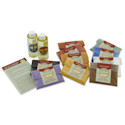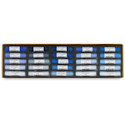Description
The Natural Earth Paint Complete Oil Paint Kit brings professional-quality oil painting into your homeschool with a focus on safety and environmental responsibility. This comprehensive kit uses naturally sourced, non-toxic ingredients to create vibrant oil paints that deliver exceptional color brilliance while maintaining archival quality standards.
Unlike conventional oil paints that may contain harsh chemicals, this kit prioritizes family safety without compromising on artistic results. The paints offer excellent UV resistance and durability, ensuring your children’s artwork remains vibrant for generations. The complete kit format eliminates guesswork about what supplies you need, making it an ideal choice for families new to oil painting or those looking to expand their art curriculum.
The natural formulation appeals to families who value environmentally conscious choices while still wanting professional-grade results. These paints perform like traditional oils but give parents peace of mind about what their children are working with during art lessons.
Value and Investment
This kit represents solid educational value for homeschooling families. The archival quality means completed paintings become lasting keepsakes rather than temporary projects. The natural, non-toxic formulation reduces health concerns that often worry parents about introducing oil paints to younger artists.
The complete kit approach saves money compared to purchasing individual components separately, while the durable nature of oil paints means this investment will support multiple children and years of art education. The UV-resistant properties ensure finished works won’t fade quickly, preserving the investment in both materials and your children’s creative efforts.
How Homeschoolers Can Use This Product
Educational Benefits
Oil painting develops fine motor skills, hand-eye coordination, and patience in ways that faster-drying mediums cannot. The slower working time of oils teaches children to plan their compositions thoughtfully and work deliberately. This medium naturally encourages the development of focus and attention span as students learn to build up layers and blend colors gradually.
The natural ingredients provide opportunities to discuss environmental stewardship and traditional art-making processes. Students can explore how artists throughout history created their own pigments from earth materials, connecting art education to science and history lessons.
Cross-Curricular Connections
Science Integration: Explore color theory, light reflection, and pigment chemistry. Discuss how natural minerals and plant materials create different colors. Study the science behind paint consistency, drying times, and chemical reactions that occur as oil paints cure.
History Lessons: Research master painters who used oil techniques, from Van Eyck to contemporary artists. Study different art movements and how oil painting evolved across cultures and time periods. Create timeline projects featuring famous oil paintings alongside historical events.
Geography Studies: Explore regions where natural pigments originate. Map the sources of different earth materials used in traditional paint making. Study how geographical differences influenced artistic styles and available colors in different regions.
Practical Art Activities
Beginner Projects: Start with simple still life compositions using basic color mixing. Practice brush techniques and color gradation exercises. Create small landscape studies to understand atmospheric perspective and color temperature.
Intermediate Explorations: Develop portrait skills with family member studies. Experiment with different brush techniques and palette knife work. Create seasonal artwork that can be displayed throughout your home, building a family art collection.
Advanced Techniques: Study master painting techniques through copying exercises (a traditional art education method). Explore glazing techniques and underpainting methods. Document art learning progress with before-and-after comparison pieces.
Lesson Extensions and Projects
Art History Studies: Pair painting sessions with research about specific artists or time periods. Create artwork “in the style of” different masters while learning about their techniques and historical contexts.
Nature Studies: Use the natural paint theme to enhance outdoor science lessons. Paint botanical studies, geological formations, or wildlife observations. Connect art-making directly to nature study documentation.
Portfolio Development: Build a family art portfolio showcasing each child’s progression. Document techniques learned and create artist statements for each piece, developing writing skills alongside artistic ones.
Practical Homeschool Tips
Workspace Setup: Oil paints require good ventilation but work well in dedicated art spaces. Set up near windows for natural light, and use disposable palettes to minimize cleanup time during busy homeschool days.
Scheduling Considerations: Plan oil painting sessions when you have longer blocks of time, as the medium works best without rushing. Consider afternoon art sessions when other subjects are completed, allowing for natural light and relaxed creativity.
Age Adaptations: Younger children can focus on color mixing and simple brush techniques, while older students can tackle more complex compositions and advanced techniques. The natural, non-toxic formula makes this suitable for a wider age range than traditional oil paints.
Cleanup and Storage: Teach proper brush care and paint storage as part of the art education. These life skills transfer to other areas and teach responsibility for materials. The natural ingredients make cleanup safer but still require proper techniques.
Assessment Integration: Use completed paintings for portfolio assessment, documenting artistic growth over time. Encourage students to write about their artistic choices and problem-solving approaches, integrating language arts with visual arts education.





Reviews
There are no reviews yet.